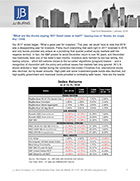The first half of 2008 dramatically reinforced the idea that over the short term the stock market is predictably unpredictable. A sharply negative first quarter was followed by two months of positive returns, but the sell off resumed with a vengeance in June, with large-cap stocks dropping nearly 9%. The phrase “June gloom” is used by residents of the Southern California coast to describe the cold and fog that persists this time of year, and it could also be used to describe investors’ moods as the quarter came to an end. Fluctuation is the mainstay on Wall Street as markets continue to be a bit volatile. The S&P is now down 12% for the first half of this year, and is about 18% below its October 2007 high. The market offered few places to hide. Mid and smaller-cap stocks fared better then large in the second quarter, but still got slammed in June and now have high single-digit losses for the first half of 2008. Foreign stocks were down nearly 11% based on respective benchmarks through the first half. More closely financial stocks continue the “subprime slime dive”. De-leveraging of banks balance sheets continues. Gold is up but at the time of this writing oil has begun to slip and as such stocks have bounced back. Many are confused and concerned and lets face it, it’s hard to keep up with all the news, and furthermore what is important for you to know as it relates to your portfolio.
The US Economy continues to struggle, weighed down by the combined effects of three formidable shocks: the housing slump, the credit cruch and the spoke in energy prices, the latter of which is not only depressing activity but also putting upward pressure on inflation. My colleague, and Chief Economist, Josh Feinman at Deutsche Bank offered up a few thoughts with me recently:
- The downdraft in housing continues, with activity and prices still falling while foreclosures and delinquincies rise. And the run up in energy prices has persisted, heightening concerns about “stagflation” (slower growth with rising prices).
- As the Bear Sterns bailout occurred, sentiment in financial markets improved considerably in April and May, as fears of a collapse of the financial system and a sharp deterioration in economic activity receded. More recently, though, renewed concerns have reemerged. This time, it’s less fears of an imminent collapse and more a recognition that the housing and credit shocks may weigh on economic activity for a longer time.
Despite all the negative shocks, the economy has been able to keep its head above water – a testament to its underlying resiliency, an aggressive Fed policy response and the relative strength of global growth.
- Real GDP has continued to advance – even at a slower pace.
- Jobs market has softened, but huge layoffs are unlikely as companies are more efficient.
- Consumer sentiment has declined, reflecting higher energy prices, declining house and equity prices and softer labor markets.
- Consumer spending has moderated and has been helped by rebate check stimulus.
- Business investment has been sustained, supported by the solid financial condition of many firms.
- The weaker dollar continues to boost US exports and strong overseas demand.
Looking Ahead:
- The US Stock Market tends to discount shares ahead of news. Therefore, when news is announced stocks as of recent may rally.
- Lagged effects of spillovers from housing and tighter credit as banks clean up the “subprime slime” (de-leverage), higher energy prices will likely continue to exert a drag on activity for some time.
- Credit markets are sending a signal with widening spreads – creating opportunities in bonds, specifically US Agency and High Yields.

- Economic activity will remain sluggish for a while, but then gradually claw its way back toward trend-like growth as housing bottoms, credit markets heal and energy prices stabilize.
- Headline inflation will likely remain elevated for a time, reflecting higher commodity prices. But inflation expectations remain time. The Fed may just have this right.
- The Fed is on hold for the foreseeable future.
Portfolio Management: Financial Market Outlook
- Sentiment in financial markets has swung wildly this year amid shifting perceptions of the fallout from the housing slump and credit cruch with gyrating energy prices complicating the landscape.
- Recently the tide has shifted again, amid concerns about Fannie and Freddie credit. In an historic speech the US Treasure Secretary reaffirmed the obligations of this debt.
- With this, bonds have become and oasis of opportunity. As banks get fixed, credit spreads will likely narrow while earning higher income in portfolios.
- Treasury yields will ultimately narrow boosting bond portfolios.
- US Stocks will rebound but will likely do so when least expected as Equities will predict rather then follow.
- Pay more attention to the credit markets for economic conditions. Bonds tend to be more indicative of the current economic climate.
- The stock market has priced in most of the financial/economic news and now point to the future.
- Markets tend to have fits of fury as they bottom.
- Asset Allocation/diversification works – we will maintain allocation and add value when we can.

I was thinking about the $300 billion housing package that Congress is working on right now – kind of like what we did in the early ‘90’s, when we put together the Resolution Trust Corp for the S&L bailout. Ultimately, the tide will turn and will do so when you least expect. Warren Buffet once said, “when the tide goes out, you get to see who is swimming naked”. Maintaining a well-diversified and allocated portfolio planned months/years ago, goes a long way to protecting your portfolios assets when the tide goes out.
Feel free to contact me or anyone on our JJBCo. team if you have any questions. Until our next communication, stay cool and enjoy the summer.
JJ Burns, CFP
President & CEO
Disclosure: J.J. Burns & Company, LLC is a registered investment adviser with the U.S. Securities & Exchange Commission and maintains notice filings with the States of New York, Florida Pennsylvania, New Jersey, Connecticut, Georgia, Illinois, North Carolina, and California. J.J. Burns & Company, LLC only transacts business in states where it is properly registered, or excluded or exempted from registration. Follow-up and individualized responses to persons that involves either the effecting or attempting to effect transactions in securities, or the rendering of personalized investment advice for compensation, as the case may be, will not be made absent compliance with state investment adviser and investment adviser representative registration requirements, or an applicable exemption or exclusion.
All investing involves risk, including the potential for loss of principal. There is no guarantee that any investment plan or strategy will be successful.
The foregoing content reflects the opinions of J.J. Burns & Company, LLC and is subject to change at any time without notice. Content provided herein is for informational purposes only and should not be used or construed as investment advice or a recommendation regarding the purchase or sale of any security. There is no guarantee that the statements, opinions or forecasts provided herein will prove to be correct.
Past performance may not be indicative of future results. Indices are not available for direct investment. Any investor who attempts to mimic the performance of an index would incur fees and expenses which would reduce returns.
Securities investing involves risk, including the potential for loss of principal. There is no assurance that any investment plan or strategy will be successful.


